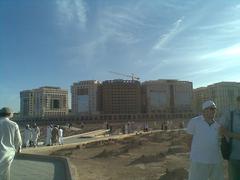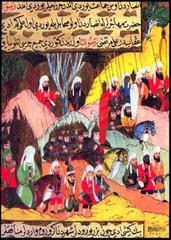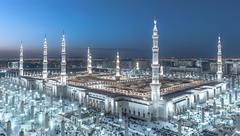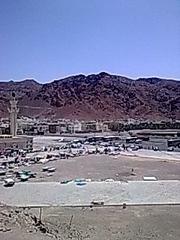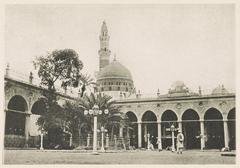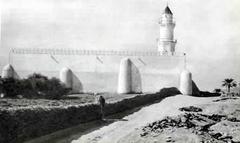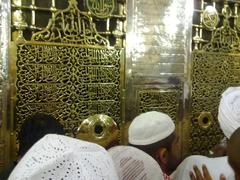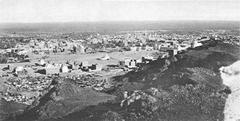Mosque of Bani Haram Medina: Visiting Hours, Tickets, and Historical Significance
Date: 04/07/2025
Introduction
The Mosque of Bani Haram, located in the historic city of Medina, Saudi Arabia, stands as a testament to early Islamic heritage and spiritual tradition. Deeply connected to the life and legacy of the Prophet Muhammad—particularly during the pivotal Battle of the Trench (Ghazwat al-Khandaq)—the mosque offers visitors a rare opportunity to engage with Islamic history beyond the more frequented landmarks such as Al-Masjid an-Nabawi. Its understated architecture, constructed from traditional local materials like stone and mud-brick, reflects the humility and functionality of early Islamic design. The mosque’s proximity to the Cave of Bani Haram further enhances its religious and historical significance, making it an essential stop for pilgrims and history enthusiasts exploring Medina’s Islamic heritage (thesimpletravel.com).
This comprehensive guide covers the mosque’s historical context, architectural features, visiting hours, ticket and entry policies, practical travel tips, accessibility, nearby attractions, and recommended best practices for a respectful visit. For further planning, consult resources such as Visit Al Madinah, Saudi Arabia Immigration, and The Simple Travel.
Table of Contents
- Introduction
- Location and Getting There
- Historical Context and Cultural Significance
- Architectural Features and Symbolism
- Renovations and Preservation
- Lighting, Ambience, and Artistic Elements
- Visiting Hours, Tickets, and Accessibility
- Facilities and Amenities
- Special Events and Guided Tours
- Photographic Spots
- Best Times to Visit
- Safety and Security
- Nearby Attractions and Suggested Itineraries
- Practical Tips
- FAQ
- Visuals and Media
- Related Articles
- Conclusion
- Sources
Location and Getting There
Geographic Setting
The Mosque of Bani Haram is situated on the western side of Mount Sela (Jabal Sela), approximately 3 kilometers northwest of Al-Masjid an-Nabawi, in an area historically inhabited by the Bani Haram tribe (Wikipedia; 3Rooj). Its location makes it accessible for visitors exploring Medina’s religious and historical landscape.
Access
- By Air: The nearest major airport is Prince Mohammad bin Abdulaziz International Airport, about 20 km from Medina’s center.
- By Road: Taxis and ride-hailing services (Uber, Careem) are widely available and the most convenient for visitors.
- By Public Transport: Public buses serve the city, though direct routes to the mosque are limited (Visit Al Madinah). From central Medina, the mosque is a short taxi ride or a 30–40 minute walk.
- On Foot: The mosque is within walking distance of the Seven Mosques complex and the Bani Haram Cave. The area near Mount Sela is urban with gentle inclines; comfortable shoes are recommended (3Rooj).
Historical Context and Cultural Significance
The Mosque of Bani Haram is closely associated with the Prophet Muhammad and his companions, who are believed to have visited and prayed at this site during the Battle of the Trench (thesimpletravel.com). Its spiritual and historical value is amplified by its proximity to the cave where the Prophet prayed and received revelations, making it a revered destination for pilgrims seeking deeper connection with Medina’s Islamic legacy (Islam Reference).
Architectural Features and Symbolism
Foundation and Walls
The mosque is traditionally constructed from locally sourced stone and mud-brick, providing insulation against Medina’s desert climate and symbolizing a strong connection between the land and the act of worship (cuddlynest.com).
Roof and Columns
A flat or gently sloped roof, often supported historically by palm trunks, characterizes the mosque’s humble architecture. Later renovations may use more durable materials but strive to maintain the original aesthetic.
Prayer Hall
The central prayer hall is simple and minimally ornamented, designed to focus attention on worship. The space is open and carpeted, fostering a contemplative atmosphere.
Mihrab and Qibla Wall
A modest mihrab indicates the qibla (direction of Mecca). The qibla wall may feature subtle geometric patterns or Quranic calligraphy, echoing Islamic artistic traditions (cuddlynest.com).
Minaret
Consistent with its humble style, the mosque either lacks a minaret or features a small, functional one to call worshippers to prayer.
Courtyard and Surroundings
A small courtyard (sahn) provides additional space for worshippers and social interaction. The mosque’s setting near the Cave of Bani Haram enhances its historical depth (thesimpletravel.com).
Renovations and Preservation
The mosque has undergone careful renovations to preserve its historical character while ensuring structural integrity for modern visitors (cuddlynest.com).
Lighting, Ambience, and Artistic Elements
Natural light streams through small windows or light wells, creating a serene ambience. Decorative elements are limited to geometric patterns and calligraphy, reflecting the mosque’s emphasis on spiritual contemplation.
Visiting Hours, Tickets, and Accessibility
- Visiting Hours: Open daily from dawn (Fajr) to night (Isha) prayer. Hours may vary during Ramadan and public holidays; check locally for updates.
- Tickets/Entry: Entry is free; all worshippers and respectful visitors are welcome.
- Dress Code: Modest dress is required. Men should wear long trousers and sleeves; women must wear an abaya and cover their hair (Visit Al Madinah).
- Non-Muslim Access: Non-Muslims are generally restricted from central Medina, though regulations for historic outskirts sites may vary—verify before visiting (MakeMyTrip).
- Physical Accessibility: The mosque is accessible by car with generally flat terrain, but the Bani Haram Cave requires a short hike and is not wheelchair-friendly.
- Language: Arabic is the primary language; English is spoken in hotels and by some taxi drivers.
Facilities and Amenities
- On-site: Basic ablution (wudu) and prayer areas; no visitor center, gift shop, or café (Trek Zone).
- Nearby: Small grocery stores and local eateries; more extensive facilities are available in the central Medina area (Visit Al Madinah).
- Restrooms: May not be available on-site; use facilities at your hotel or larger mosques before visiting.
Special Events and Guided Tours
The mosque sees increased visitation during Islamic months such as Rabi’ al-Awwal and the Hajj/Umrah seasons. Guided tours are often available through local operators, providing deeper cultural and historical context.
Photographic Spots
The mosque’s exterior, nearby Mount Sela, and the Bani Haram Cave offer excellent photo opportunities. Photography inside prayer areas is discouraged unless explicit permission is granted.
Best Times to Visit
- Climate: The best visiting period is October to May, when temperatures are milder (MyHolidays).
- Religious Calendar: Visiting outside peak pilgrimage seasons (Hajj, Umrah) offers a quieter experience.
Safety and Security
Medina is considered one of Saudi Arabia’s safest cities, with a strong security presence around religious sites (Regency Holidays). Always safeguard belongings and stay aware of surroundings.
Nearby Attractions and Suggested Itineraries
- The Seven Mosques (Sab’ah Masajid): A complex of historic mosques within a 7-minute walk (MyHolidays).
- Bani Haram Cave: Adjacent to the mosque; accessible after a short hike (3Rooj).
- Mount Sela: Offers panoramic views and historical insights.
- Al-Masjid an-Nabawi: The second holiest site in Islam, approximately 3 km away (Wikipedia).
A visit can be combined with these sites for a 1–2 hour historical tour.
Practical Tips
- Bring water, sun protection, and comfortable shoes.
- Plan visits during early morning or late afternoon to avoid heat.
- Carry identification and a copy of your visa.
- Download offline maps.
- Learn basic Arabic greetings to facilitate communication.
FAQ
Q: What are the Mosque of Bani Haram’s visiting hours?
A: Generally open for the five daily prayers, accessible during daylight hours; confirm times locally during Ramadan and holidays.
Q: Is there an entry fee or ticket required?
A: No entry fee or ticket is required.
Q: Are non-Muslims allowed to enter?
A: Non-Muslims are typically restricted from central Medina; check current regulations for historic outskirts sites.
Q: Are guided tours available?
A: Yes, local operators offer guided tours, especially during pilgrimage seasons.
Q: Is the mosque accessible for people with disabilities?
A: The mosque is accessible by car; the nearby cave is not wheelchair-friendly.
Visuals and Media
Alt text: Mosque of Bani Haram exterior view in Medina.
Alt text: The Cave of Bani Haram adjacent to the mosque.
Related Articles
- The Seven Mosques Complex
- Mount Sela History
- Top Historical Sites to Visit in Medina
- A Guide to Al-Masjid an-Nabawi
Conclusion
The Mosque of Bani Haram is a vital spiritual and historical landmark within Medina, offering visitors a profound connection to the early days of Islam. Its simple yet meaningful architecture, free access, and proximity to significant sites like the Cave of Bani Haram and the Seven Mosques make it an essential addition to any Medina itinerary. Adhering to cultural customs and respectful conduct ensures a rewarding and contemplative visit. For enhanced experiences, consider guided tours during special religious seasons and utilize digital resources such as the Audiala app for updates, maps, and historical insights.
Sources
- The Simple Travel, 2024, Things to Do in Medina
- Cuddlynest, 2024, Medina Mosque: The Spiritual Heart of Islam
- Wikipedia, 2024, Mosque of Bani Haram
- 3Rooj, 2024, Cave of Bani Haram
- Visit Al Madinah, 2024, How to Visit Medina Saudi Arabia
- Trek Zone, 2024, Mosque of Bani Haram Medina
- Regency Holidays, 2024, Mosques in Medina Saudi Arabia
- MakeMyTrip, 2024, Places to Visit in Medina
- Saudi Arabia Immigration, 2024, Exploring Medina Your Perfect Vacation Spot
- Islam Reference, 2024, Medina - Al Madinah
- MyHolidays, 2024, Places to Visit in Medina Saudi Arabia
